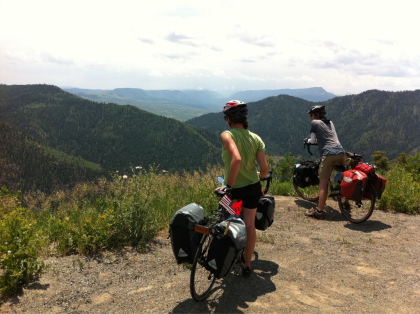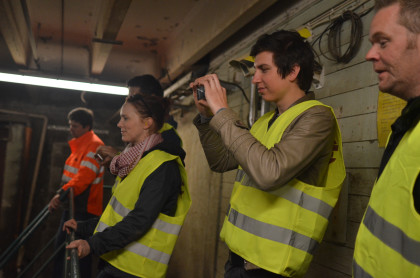Designers and Forests grew out of two seemingly unrelated events. The first was a journey on bicycle across the United States. The second was the collapse of the economy of Iceland.
In the summer of 2011, project co-founder Jason Dilworth biked across the North American continent and was disturbed by what he saw in the Western United States—whole mountainsides of dead or dying pine and aspen trees. He also saw towns dying or turned into economic monocultures dependent on the whim of one employer, their diversity and self-sufficiency lost to the international economy. He told another designer, project co-founder Megan Urban. She was also disturbed by the maple, ash, and hemlock trees she saw dying in Eastern forests and by the decimation of the towns she grew up in as their industries moved to other parts of the United States or overseas. The two designers realized there were many similarities in the problems that plagued these two different regions but were at a loss for what they could do to help.
A year later, Jason and Megan found their way to Iceland, a country that has withstood a massive shock in the Fall of 2008. That October, Iceland’s banking sector disintegrated under the weight of liabilities over ten times larger than the country’s GDP, sending the nation into a period of double digit inflation, unprecedented unemployment, and currency devaluation. Three years later, the country began to emerge from its crisis transformed. The driving forces of the new economy included design and the arts, as documented in the government sponsored publication “Towards Creative Iceland: building local, going global” Towards Creative Iceland. In this new economy, creative endeavors were sources of not only monetary gains, but community stability and growth.
Jason and Megan wondered how this creative economy had taken hold and who or what was driving it. These questions guided the designers on their summer 2012 trip as they travelled around Iceland to find answers, meeting with some of the arts organizations, designers, and government officials responsible for this paradigm shift. They experience a society that had been shaped by its history, size, geology, and of course, the vagaries of its economy, Jason and Megan found people that prized independence, community, family, learning, and history, yet also seemed open to new ideas, alternative methods of thought, and ingenious solutions. Surprisingly, they heard one phrase repeated over and over; “the collapse was actually a blessing.”
It was a blessing because it forced people to re-evaluate their priorities, to take stock and decide what mattered, and to rediscover the strength that had allowed their ancestors to survive in such an unforgiving environment. The collapse was also a particular blessing to artists and other creatives because their way of thinking, often antithetical to the modes of thought that dominated the financial industry that had laid the country low, were given increased attention. Their ideas, so hard to quantify in financial terms, were now valuable for how they contributed qualitatively to individual communities and society as a whole.
While Jason and Megan met many individuals they met, all inspiring them with the possibilities to be found in their own town, county , state and country, it was a group in East Iceland that directly lead to the establishment of the Designers and Forests Project. There they met some of the people behind MAKE By Þorpið including Project Manager Lára Vilbergsdóttir. This project provides an alternative to the region’s growing economic monoculture through workshop space, instruction, and assistance to aspiring and established artisans and designers, Instead of a single focal point, make links together different communities with creative spaces dedicated to the materials and crafts endemic to each town. It also helps artists retail their goods and acts as a bridge to businesses, museums, and institutions on local, regional, national, and international levels. The success of the project was evidenced by the fact that Jason and Megan had seen product make had incubated in stores around the country.
When the two designers returned to the United States, their experience stayed with them. As a result, when make sponsored the Make it Happen conference in last September of 2012, Megan returned to East Iceland to continue to learn from the project and its experiences. (As covered in Disegno Magazine)
At this fascinating conference, Megan met Victor Strandgren and Daniel Bystöm, instructors at Nässjö Akademy/ Jönköping University in Sweden. They had brought students to East Iceland to collaborate with make in the creation of products inspired by local materials. Daniel was also a key note speaker at the conference where he shared his experiences with destination design. In Daniel and Victor’s work, Megan saw the sort of projects she had envisioned with Jason so she introduced herself and began a conversation that continued through email, Skype, and finally, in person. She and Jason travelled to Nässjö early in the summer of 2013, and the discussions grew into the collaborative Designers and Forests and the Beetle Kill and Aspen Die -Off project that began in Utah in the summer of 2013.


